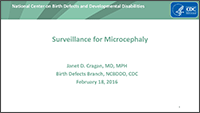Facts about Microcephaly
Microcephaly is a birth defect where a baby’s head is smaller than expected when compared to babies of the same sex and age. Babies with microcephaly often have smaller brains that might not have developed properly.
What is microcephaly?
Microcephaly is a condition where a baby’s head is much smaller than expected. During pregnancy, a baby’s head grows because the baby’s brain grows. Microcephaly can occur because a baby’s brain has not developed properly during pregnancy or has stopped growing after birth, which results in a smaller head size. Microcephaly can be an isolated condition, meaning that it can occur with no other major birth defects, or it can occur in combination with other major birth defects.
What is severe microcephaly?
Severe microcephaly is a more serious, extreme form of this condition where a baby’s head is much smaller than expected. Severe microcephaly can result because a baby’s brain has not developed properly during pregnancy, or the brain started to develop correctly and then was damaged at some point during pregnancy.
Other Problems
Babies with microcephaly can have a range of other problems, depending on how severe their microcephaly is. Microcephaly has been linked with the following problems:
- Seizures
- Developmental delay, such as problems with speech or other developmental milestones (like sitting, standing, and walking)
- Intellectual disability (decreased ability to learn and function in daily life)
- Problems with movement and balance
- Feeding problems, such as difficulty swallowing
- Hearing loss
- Vision problems
These problems can range from mild to severe and are often lifelong. Because the baby’s brain is small and underdeveloped, babies with severe microcephaly can have more of these problems, or have more difficulty with them, than babies with milder microcephaly. Severe microcephaly also can be life-threatening. Because it is difficult to predict at birth what problems a baby will have from microcephaly, babies with microcephaly often need close follow-up through regular check-ups with a healthcare provider to monitor their growth and development.
Occurrence
Microcephaly is not a common condition. State birth defects tracking systems have estimated that microcephaly ranges from 2 babies per 10,000 live births to about 12 babies per 10,000 live births in the Unites States.1
Causes and Risk Factors
The causes of microcephaly in most babies are unknown. Some babies have microcephaly because of changes in their genes. Other causes of microcephaly, including severe microcephaly, can include the following exposures during pregnancy:
- Certain infections during pregnancy, such as rubella, toxoplasmosis, or cytomegalovirus
- Severe malnutrition, meaning a lack of nutrients or not getting enough food
- Exposure to harmful substances, such as alcohol, certain drugs, or toxic chemicals
- Interruption of the blood supply to the baby’s brain during development
Some babies with microcephaly have been reported among mothers who were infected with Zika virus while pregnant. CDC scientists announced that enough evidence has accumulated to conclude that Zika virus infection during pregnancy is a cause of microcephaly and other severe fetal brain defects.
CDC continues to study birth defects, such as microcephaly, and how to prevent them. If you are pregnant or thinking about becoming pregnant, talk with your doctor about ways to increase your chances of having a healthy baby.
Zika Virus and Pregnancy
For information about the effects of Zika virus infection during pregnancy, visit CDC’s Zika and Pregnancy web page.
Diagnosis
Microcephaly can be diagnosed during pregnancy or after the baby is born.
During Pregnancy
During pregnancy, microcephaly can sometimes be diagnosed with an ultrasound test (which creates pictures of the body). To see microcephaly during pregnancy, the ultrasound test should be done late in the 2nd trimester or early in the third trimester. For more information about screening and confirmatory tests during pregnancy, visit CDC’s birth defects diagnosis web page.
After the Baby is Born
To diagnose microcephaly after birth, a healthcare provider will measure the distance around a newborn baby’s head, also called the head circumference, during a physical exam. The provider then compares this measurement to population standards by sex and age. Microcephaly is defined as a head circumference measurement that is smaller than a certain value for babies of the same age and sex. This measurement value for microcephaly is usually less than 2 standard deviations (SDs) below the average. The measurement value also may be designated as less than the 3rd percentile. This means the baby’s head is extremely small compared to babies of the same age and sex.
Head circumference growth charts for newborns, infants, and children up to age 20 years in the United States can be found on CDC’s growth charts website. Head circumference growth charts based on gestational age at birth (in other words, how far along the pregnancy was at the time of delivery) are also available from INTERGROWTH 21st. CDC recommends that health care providers use the WHO growth charts to monitor growth for infants and children ages 0 to 2 years of age in the United States.
Microcephaly can be determined by measuring head circumference (HC) after birth. Although head circumference measurements may be influenced by molding and other factors related to delivery, the measurements should be taken on the first day of life because commonly-used birth head circumference reference charts by age and sex are based on measurements taken before 24 hours of age. The most important factor is that the head circumference is carefully measured and documented. If measurement within the first 24 hours of life is not done, the head circumference should be measured as soon as possible after birth. If the healthcare provider suspects the baby has microcephaly, he or she can request one or more tests to help confirm the diagnosis. For example, special tests like like magnetic resonance imaging can provide critical information on the structure of the baby’s brain that can help determine if the newborn baby had an infection during pregnancy. They also can help the healthcare provider look for other problems that might be present.
Webinar on Surveillance
Treatments
Microcephaly is a lifelong condition. There is no known cure or standard treatment for microcephaly. Because microcephaly can range from mild to severe, treatment options can range as well. Babies with mild microcephaly often don’t experience any other problems besides small head size. These babies will need routine check-ups to monitor their growth and development.
For more severe microcephaly, babies will need care and treatment focused on managing their other health problems (mentioned above). Developmental services early in life will often help babies with microcephaly to improve and maximize their physical and intellectual abilities. These services, known as early intervention, can include speech, occupational, and physical therapies. Sometimes medications also are needed to treat seizures or other symptoms.
Other Resources
The views of these organizations are their own and do not reflect the official position of CDC.
Mother To Baby (on behalf of the Organization of Teratology Information Specialists)
This website provides comprehensive information to mothers, healthcare professionals, and the general public about exposures during pregnancy.
References
- National Birth Defects Prevention Network. Major birth defects data from population-based birth defects surveillance programs in the United States, 2006-2010. Birth Defects Research (Part A): Clinical and Molecular Teratology. 2013;97:S1-S172.
- Page last reviewed: December 7, 2016
- Page last updated: December 7, 2016
- Content source:



 ShareCompartir
ShareCompartir


